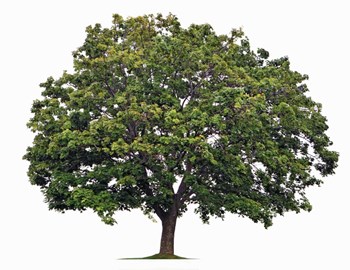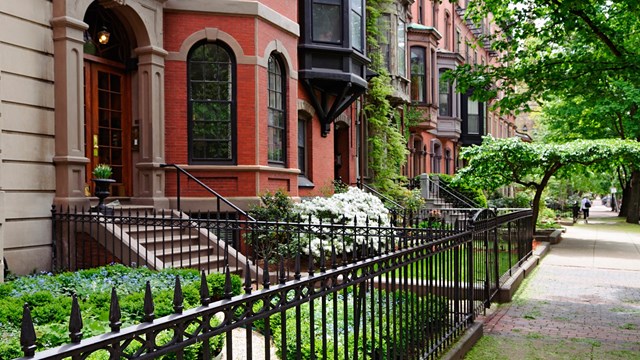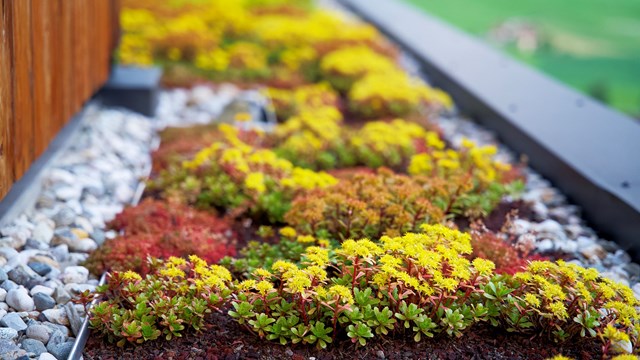
The trees that grace the outdoor spaces at most community properties provide untold value. But have your lovely spring-flowering pear trees lost branches this winter? Are those once-trim blue spruces suddenly blocking the entryway signs?
The landscape trees planted by contractors during construction of many New England communities were a major investment, and they are now mature. But if the trees were not suitable for the property in the first place, are not taken care of properly, or even neglected, then the condominium can lose its investment value.
One way that trees can be damaged is by performing work below grade that is too close to them. Mary Anne O’Neill, a landscape architect and designer at Leahy Landscaping in Lynn, Massachusetts, warns that at the very least, “you should not work within the canopy of the tree. In most species, the roots extend even beyond the canopy… and much of the root systemis in the uppermost 18 inches of soil.”
She cites a recent situation in which “a client had a big addition being builtand wanted to keep the mature trees, but the construction would have invaded the roots.” This can mean a slow death for trees, “although you may not find this out for a couple of years,” O’Neill states. “It’s better to take down nearby trees [being impacted] during construction, and plant younger ones, which will acclimate to their surroundings. If you try to keep mature trees and their roots get damaged, they’ll die and you’ll have to remove them anyway.”
She recommends matching the type of tree that best suits a specific site. “Street trees” especially, have an important role in development plans – but roadsides are a potentially stressful environment. “You want trees that can withstand city conditions,” such as exhaust and fumes, she notes. “Some good choices are sycamore, linden, American ash and zelkova,” which is a Japanese import that makes a good replacement for elm. “These are trees that are hardy, with low maintenance, and have high branches,” she says, adding that size, spread and shape are important to consider in the space allotted for the tree as it reaches full size.
Pruning and “Bracing” are First Steps
Planning how trees will mature means anticipating site-specific issues, agrees Marc Bolcome, a certified arborist at Leahy. “The biggest problem I see is communities spending money replacing [failed] plantings rather than insisting on proper preparation in the first place. When I begin the [landscaping] process with a client, I start with existing plants and identify all trees and shrubs that are under stress… Often the first step is structural pruning or bracing” as well as trimming branches that are likely to break.
“My first priority is safety,” he continues, “Do branches have sufficient clearance to buildings, are signs or house numbers hidden by foliage, are lamp posts or lighting fixtures covered up with over-growth?”
When working for communities, he says, “I try to report directly to the board, and craft a plan that is appropriate for their budget… Plans we’ve provided have ranged from $3,000 to $20,000 per year. We give the board a plan [for maintenance] and each year I inspect the property and revise the plan as time goes by. I don’t just hand them a plan and walk away. ..
“The biggest obstacle is condo boards that don’t have a line item for trees in their budget,” Bolcome states. He customizes maintenance plans that associations can adopt, and cites one example in Salem, Massachusetts, with over 200 units. “We broke it into quadrants, assigning one year to each quadrant,” thereby covering the wholeproperty in a four-year cycle. “For another property in the same city,” he adds, “we worked all over the property addressing immediate needs and attending to the most stressed trees.”
“What I find,” he notes, “is that most landscape architects are not arborists. Sometimes trees are planted too deep, or in a location where they will overgrow their space. If they are planted too close to buildings it can result in trapped moisture and future mold problems.”
“My other priority, besides safety,” Bolcome continues, “is maintaining structural control within tree specimens. You want to avoid over-pruning or shearing… The wrong decisions with pruning will kill a tree, such as trying to do a major pruning all at once. It may take two or three years of selective pruning to achieve the best shape and a supportive structure.”
Tree Trends Encouraged “Invasives”
Over the years, landscape designers have experimented with numerous imported species that rose in popularity but eventually fell from grace when they were found to be invasive. “Things like burning bush and barberry were planted everywhere,” says Bolcome. Growth was prolific, “and seeds wouldbe carried by birds, out into the wild, and they would edge out the native plants. Norway maple, especially, was a popular street tree for its hardiness, but it will choke out the oak trees. Its roots are very invasive… [it can] clog sewer systems.”
Once invasive plants are identified, they become banned, he reports, “The U.S. Department of Agriculture determines [the list of] problem, invasive species, and prohibits their sale” at nurseries and garden centers.
It’s also a problem when a tree becomes trendy with urban planners and contractors – and becomes over-planted, he states. “For instance, years ago, chestnut trees were over-planted and then died from a blight. Many werereplanted with elms, and then they succumbed to disease. The Norway maple has also been over-planted… maybe it will be eliminated the same way.”
Bolcome isn’t the only arborist who mentions safety as a first priority with tree care. It is also a concern of James McGuire, president of Hartney Greymont, Inc., an arborist firm in Needham, Massachusetts. When trunksare diseased or large branches hang precariously they become “hazard trees… and unsafe,” he says, “becoming a liability." And he adds, there’s a certain expectation for legal responsibility by caretakers and managers. “Also, trees growing too close to buildings can encourage pests such as squirrels and insects that make their way indoors… pine sawyers and the brown marmorated stinkbug.”
McGuire notes that over the years, many contractors planted evergreen trees and shrubs simply “because they’re cheaper,” and crowded them too close to buildings where they can cause moisture problems. He recommends using dwarf conifers and azaleas – plants that mature to only two to four feet in diameter –where space is confined. He points out that rhododendrons are very popular but can reach eight to twelve feet and often outgrow their space.
Just as bad is plopping them – or any plant – into conditions they don’t do well in. “We looked at a project,” he says, “where the clients had rhododendrons planted in full sun next to a rain downspout. Rhodies don’t like ‘wet feet’ or too much sun.” As an alternate choice in shrubs, he recommends red vein enkianthus, a spring-flowering relative of the rhododendron, because, he states, “It stays narrow at about six to eight feet.”
Another trendy landscape tree to avoid, he reports, “is the Bradford pear… which is popular because it flowers and is insect-free, but structurally it’s a poor tree” and won’t hold up to snow or ice loading. “A better flowering tree is the saucer or star magnolia.” His firm found a solution for a residential complex in Needham, McGuire relates: “We took out some Norway maples and Bradford pears andreplaced them with several varieties of flowering crab apple trees,” which are compact, sturdy and well-suited to local conditions.
McGuire also warns against shearing – as is often seen in hedge-clipping – that lops off the outermost tips of branches and twigs. While this causes the external foliage to become dense, “it will eventually hollow out the interior and thin the branches from the bottom,” he notes. “You want to encourage the interior growth; to do that, you must hand-prune. Trees need periodic pruning to reduce the likelihood of breakage during storms, as well as maintaining clearance around lighting and signage… When pruning is done correctly, you can keep a plantgrowing forever.”
What Lies Below?
Sometimes contractors expect a quick cover of loam and seed to take the place of an actual landscaping plan. Frank G. Cover, MCA, principal in Frank G. Cover Tree Care Specialists of Dunstable, Massachusetts, notes that soils are important, but success with plantings starts even below the soil. When units and roadways are under construction, he says, “you’ll see [contractors] trying to cover ledge with topsoil. The engineers may have overlooked a simple thing like drainage [through the landscape], or the fact that some soils simply won’t support plantings.” Then landscape plants die or the soil erodes or washes away – nota good visual in a new development.
Landscape designers can assess topography and soils, creating a plan to accommodate ledge and rocky outcroppings, and soil adjustments can be made. The next challenge is finding species that will thrive in your particular climate and setting. Cover advises “going back 100 years to get the averages of temperature range.” It may take a long time to discover the vulnerability of an introduced species. For example, he states, “Boxwood – an English import – was very popular in Lowell, Massachusetts, until one year, the winter was very cold with no snow cover. All the boxwood died when their roots froze.” He encourages communitymanagers to pay attention to cold-hardiness zones as well as variations caused by micro-climates.
Another example of an unfortunate choice of foliage was a client in North Hampton, New Hampshire, Cover relates, “who had $20,000 worth of hemlocks planted by a tidal marsh, at the recommendation of a nursery. They didn’t last… hemlocks are not salt-tolerant, [so] they’re not good on roadsides either.”
All the experts agree that monitoring the health of trees and landscape specimens requires an arborist with a long-term commitment, since problemsare almost never evident right away. The stresses that eventually kill trees, including drought, flood, chemical dumping, insects or blight, may take years before the damage becomes obvious. A trained eye observing growth through multiple seasons can help associations keep their green investments alive and well.
Marie N. Auger is a freelance writer and a frequent contributor to New England Condominium magazine.






Leave a Comment